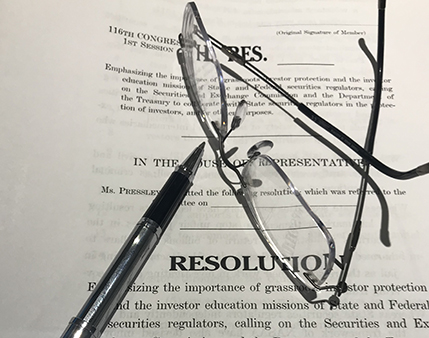Written Statement of the North American Securities Administrators Association
House Small Business Committee, Government Programs and Oversight Subcommittee
October 14, 1999
The North American Securities Administrators’ Association (“NASAA”)* welcomes the opportunity to provide input as the Government Programs and Oversight Subcommittee of the House Small Business Committee holds a hearing on “going public” issues.
The states have long been leaders in developing and administering programs that facilitate small business capital formation. These efforts consist of specialized registration and exemption programs designed to help local entrepreneurs raise seed capital to expand their businesses through small stock offerings; review programs that create uniformity and decrease costs and effort; and outreach efforts and technical assistance to help small businesses through the regulatory process.
Registration and Exemption Programs
SCOR. One of the biggest hurdles facing a small business that wants to sell its securities is the cost associated with preparing an offering. Legal fees alone for a typical small offering can amount to tens of thousands of dollars. The “Small Company Offering Registration” (SCOR) program addresses this problem through the use of a question-and-answer, fill-in-the-blank offering circular that is designed to lead an issuer through the process of creating an offering circular or prospectus that adequately discloses the features and risks of the offering. In addition to the form itself, the states have created an Issuers Manual that explains each question on the SCOR form in detail, points out common pitfalls, and provides sample responses to certain questions. NASAA recently approved changes to the SCOR form and accompanying manual to make it more user-friendly for both issuers and investors.
Once the SCOR form is completed, it must be reviewed and approved by state securities regulators. If it is a multi-state offering, one state regulator may take the lead in working with the issuer, consolidating comments by other state regulators. This process is described in our discussion of Regional Review, below. The approved SCOR form is used as the offering circular for the offering and the offering can be made “publicly,” meaning that the offering can be advertised in the newspaper, on radio, through mass mailings, or any other public means.
SCOR was first adopted more than a decade ago and is currently used in approximately 47 states. More than 1,100 companies across the country have used the SCOR program to sell shares to the public. These companies range from microbreweries to small banks and technology startups.
Offerings using the SCOR form are made in reliance upon one of three exemptions from federal securities registration: the intrastate offering exemption (SEC Rule 147), Rule 504, or Regulation A, where the SCOR form is called “Model A”. SCOR offerings are typically small. Federal Rule 504 is limited to offerings of $1,000,000 or less, while Regulation A is capped at $5,000,000. These offerings are generally too small to result in a listing on NASDAQ or any of the national or major regional stock exchanges.
Model Accredited Investor Exemption. In April 1997, state and provincial regulators approved the Model Accredited Investor Exemption (MAIE), which provides an exemption from state securities registration requirements to small businesses offering securities to accredited investors. The MAIE is based on the premise that accredited investors, defined by the SEC as wealthy individuals or institutional investors, are capable of undertaking their own due diligence and gauging the risk factors before making any investments. At the federal level, MAIE works with the SEC Regulation D, Rule 504, to provide an exemption for offerings up to $1 million. The SEC has the authority to adopt a rule that would allow offerings up to $5,000,000. It has previously used this authority to adopt Rule 1001, which provides a $5,000,000 exemption for offerings made pursuant to California Rule 25102(n).
Thirty-three states plus Puerto Rico and the District of Columbia have adopted a form of this exemption and seven more states have bills pending in their legislatures. Use of the model accredited investor exemption has resulted in greater use of the Small Business Administration’s Angel Capital Electronic Network (“ACE-Net”), which provides Internet access to “angel” or accredited investors looking to invest between $250,000 to $5 million of seed and startup capital in small businesses.
Review Programs
Coordinated Equity Review (“CER”) is available to issuers seeking to sell equity securities. It provides a uniform state registration procedure designed to coordinate the blue-sky registration process in all of the states in which the issuer seeks to sell. In addition to creating uniformity in the review, the program is designed to expedite the registration process, saving the issuer time and money. Of the 42 state securities agencies that register these types of offerings, 38 are currently participating. CER is designed to target stock offerings on the NASDAQ Small Cap, over-the-counter, and other small exchanges. The size of these offerings typically ranges from $5 million to $20 million dollars.
Pennsylvania is the coordinating state for CER. Instead of a company having to deal with each state individually, the program calls for Pennsylvania to designate two reviewing states – a lead disclosure state and a lead merit state. These two states canvass all other states and formulate one set of regulatory comments for the company. Comments are based on a uniform set of standards that the CER states have agreed upon. Once all regulatory comments are satisfied, the lead states notify all other states in which the company has filed to sell its securities that the offering is ready for registration. This process effectively shifts the compliance burden of collecting and synthesizing regulatory comments from the company to the states, saving small business much time and effort.
Thirty-two companies whose offerings ranged from $2.8 million to $36.9 million have taken advantage of CER since it began in June 1997. The issuers have praised the program as greatly streamlining the blue-sky registration process. Said one participant:
“I recently participated in the CER program with a form SB-2 and was satisfied far beyond my expectations. We cleared approximately 37 states in three weeks even though the offering presented many of the common merit issues, which normally would have been significant obstacles to registration in many states. I would not hesitate to do it again and would never revert to doing an offering the ‘old fashioned’ way.”
Regional Review. Regional Review is a coordinated effort for small regional public offerings of securities that are exempt from SEC registration under Rule 504 or Regulation A. Similar to CER, Regional Review provides a uniform state registration procedure designed to coordinate the blue-sky registration process in all states in the region in which the issuer seeks to sell. In addition to creating uniformity in the review, the program is designed to expedite the registration process, saving the issuer time and money.
As in CER, a single state is responsible for coordinating the review of all other members and communicating with the issuer to resolve outstanding comments. Once the lead state clears the application, all participating states agree to clear it as well. There are currently four participating regions – the Western, Midwestern, Northeast and Mid-Atlantic regions encompassing 33 states.
Outreach Efforts and Technical Assistance
State securities regulators reach out to small business issuers in many ways. Most states have web sites that offer access to forms, regulations, frequently asked questions and other useful information. In addition, states provide local companies and entrepreneurs with a great deal of “hands on” assistance in completing registrations or obtaining exemptions for securities offerings. With the closure of several SEC Regional and District offices, states are now often the only local regulatory agency available to assume this role. We meet regularly with local companies that wish to sell securities to explain procedures and assist in compliance with state and federal laws.
States have long realized the important role they play in small business capital formation. With the enactment of NSMIA, states were able to better concentrate their corporate finance resources on small, local offerings. State regulators are small business experts and many states have programs devoted to reaching out to and assisting the small business issuer.
Conclusion
NASAA continues to pursue initiatives that move toward the goals of assisting small businesses through the capital raising process and enhancing regulatory coordination. We commend the Subcommittee for holding this hearing and look forward to working with you on “going public” issues as well as others impacting the small business community. For more information, contact Deborah Fischione, NASAA’s Director of Policy and Office Management at 202-737-0900.
October 14, 1999












